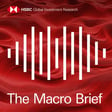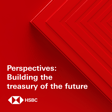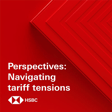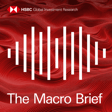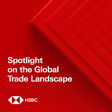Become a Creator today!Start creating today - Share your story with the world!
Start for free
00:00:00
00:00:01

The Macro Brief - EM investor attitudes, the rise of the drones, central bank update
Murat Ulgen assesses the findings from our latest survey of EM investors, Davey Jose explains why the commercial and consumer drone market is poised for huge growth and we update on central bank moves. Disclaimer: https://www.research.hsbc.com/R/51/WfnD2ML Stay connected and access free to view reports and videos from HSBC Global Research follow us on LinkedIn https://www.linkedin.com/feed/hashtag/hsbcresearch/ or click here: https://www.gbm.hsbc.com/insights/global-research.
Hosted on Acast. See acast.com/privacy for more information.
Transcript
Introduction and Podcast Details
00:00:00
Speaker
The following podcast was recorded on the 15th of June by HSBC Global Research.
00:00:04
Speaker
All the disclosures and disclaimers associated with it must be viewed on the link attached to your media player.
00:00:09
Speaker
You can find us on Apple and Spotify or wherever you get your podcasts by searching for the Macro Brief.
00:00:14
Speaker
And don't forget to give us a rating.
00:00:16
Speaker
Now, on to the podcast.
Host Introductions and Topic Overview
00:00:21
Speaker
Hello, I'm Piers Butler in London.
00:00:23
Speaker
And I'm Mary Watkins and a warm welcome everybody to our weekly Macro Brief Podcast.
00:00:28
Speaker
Here's what's coming up today.
00:00:30
Speaker
Following a tough few months for financial markets, we assess the mood among emerging market investors as we look at the results of our latest EM Sentiment Survey.
00:00:39
Speaker
We examine how the rise of commercial and consumer drones are poised to transform the way things get done across society.
00:00:46
Speaker
And we wrap up the views from our economists tracking the latest policy decisions at the Fed, ECB and the Bank of England.
EM Sentiment Survey Insights
00:00:57
Speaker
HSBC has just released its latest emerging market sentiment survey.
00:01:01
Speaker
This 12th edition in the series gives an insight into what's on the mind of major investors responsible for over half a trillion dollars of assets under management in emerging markets.
00:01:11
Speaker
We're joined by Dr. Murat Olgan, Global Head of EM Research, who has been analyzing the findings.
00:01:16
Speaker
Murat, welcome.
00:01:17
Speaker
Thank you very much.
00:01:18
Speaker
So this is the 12th survey.
00:01:20
Speaker
We've been on quite a journey since it first started.
00:01:23
Speaker
And in fact, the last survey was very bullish in terms of EM sentiment.
00:01:28
Speaker
But since then, obviously, we've had volatility in the markets.
00:01:30
Speaker
We've had people worrying about things such as the pace of the China recovery.
00:01:35
Speaker
So how does EM sentiment look like today?
00:01:38
Speaker
Sure, thank you.
00:01:39
Speaker
It's been three years since we launched the survey, the 12th quarterly edition indeed.
00:01:44
Speaker
So look, investors still retain a broadly constructive view on EM, but as you said, it's been a volatile quarter with all these things impacting the sentiment, and there have been a few changes.
00:01:54
Speaker
Actually, there is some moderation in that bullish expectation.
00:01:59
Speaker
Now investors who are outright bullish on EM, they've actually dropped to 39% from 47% in the previous survey in March.
00:02:07
Speaker
while those who are bearish, they remain unchanged at 17.
00:02:10
Speaker
So when you take the net of bullish versus bearish, it's still one of the highest readings of the last two years.
Investor Concerns and Market Outlook
00:02:17
Speaker
But similarly, consistent with that moderation of bullish expectations, we've seen cash levels picking up a bit,
00:02:23
Speaker
to 5.9% as weighted average as a share of assets under management for 5.1 earlier.
00:02:29
Speaker
And also the risk appetite score has moderated to 6.1 from 6.9, where zero is no risk in EM and 10 means highest risk in emerging markets.
00:02:40
Speaker
So if we get a bit more specific, what are EM investors worrying about now in terms of emerging markets?
00:02:45
Speaker
Yes, I mean, as you said, part of the volatility was because of a hawkish global monetary policy outlook throughout the second quarter and continued rate hikes by global center banks.
00:02:55
Speaker
So investors actually still worry about the U.S. Federal Reserve and other global center banks keeping their rates high for longer.
00:03:04
Speaker
And the other worry has been there for a while is recession in major economies.
00:03:09
Speaker
And what about on the upside?
00:03:10
Speaker
Is there anything that they're sort of thinking could be a positive catalyst?
00:03:14
Speaker
There are actually.
00:03:15
Speaker
As a matter of fact, this one what stands out is the share of investors who think a soft landing in major economies could be a major upside for EM.
00:03:24
Speaker
That share has doubled from the previous survey.
00:03:27
Speaker
And also some investors believe that inflation can actually fall to targets
00:03:31
Speaker
sooner than expected and they appear to be key upside risk for emerging markets out there.
00:03:36
Speaker
And when we were chatting ahead of this interview, you said something that really struck me, that in the sort of 25 years or so of covering emerging markets, there was a divergence in this survey that is really seen in emerging markets.
00:03:48
Speaker
Tell us what that is.
00:03:50
Speaker
So, I mean, in my own experience, the monetary cycles rarely diverge, and emerging markets are usually led by the developed market-centered banks.
00:03:59
Speaker
But interestingly in this survey, nearly two-thirds of the investors
00:04:04
Speaker
don't expect any rate cuts from the developed market center banks.
00:04:07
Speaker
Whereas there's a 40% of the investors who believe that actually emerging market center banks can lower interest rates in the next three months, which is very near term.
00:04:16
Speaker
So there is a bit of a striking divergence.
00:04:19
Speaker
And I think it's fair enough because a lot of emerging market center banks have started hiking rates a lot earlier than the developed world at the start of the cycle.
00:04:27
Speaker
So it's natural that some expect they can also start cutting earlier than the developed markets.
00:04:33
Speaker
So just to finish on, looking at the survey and in terms of potential flows, what does the survey reveal?
Regional Investment Preferences
00:04:39
Speaker
Sure.
00:04:39
Speaker
Well, first of all, Latin America is the most preferred region across the board for all asset classes.
00:04:45
Speaker
And it's quite striking because Latin already has seen a spectacular performance here today, but investors are still bullish.
00:04:52
Speaker
That's partly explained by this rising interest in EMFX and local fixed income markets by investors.
00:04:59
Speaker
And hard currency debt has actually fallen out of favor.
00:05:02
Speaker
And a lot of Latin American countries, they have a high carry-on offer.
00:05:07
Speaker
So definitely there is interest in local currency debt, NFX, and the next region after Latin America is Asia.
00:05:14
Speaker
and investors are bullish on EMFX, now 70% expects EM currencies to appreciate against the US dollar in the next three months.
00:05:22
Speaker
And consistent with the interest in local currency denominated assets, I should also mention about equities because the sentiment has improved very visibly.
00:05:31
Speaker
Now 60% of investors see EM equities rising over the next three months, doing well, and 73% think that actually EM equities will outperform EM equities over the same time horizon.
00:05:43
Speaker
An emerging market cocktail, shaken but not stirred.
00:05:46
Speaker
Murat, thank you very much for joining us today.
00:05:48
Speaker
Thanks for having me.
Central Bank Policies and Expectations
00:05:52
Speaker
Before we move on, a few central bank updates.
00:05:56
Speaker
The Fed held its latest meeting this week, where it kept rates on hold for the first time in over a year.
00:06:01
Speaker
However, it signaled more action ahead given elevated inflation.
00:06:05
Speaker
And Ryan Wang, our US economist, expects one more 25 basis point rate hike at the July meeting.
00:06:12
Speaker
the ecb also met this week and continued its tightening cycle with a twenty five basis point rise taking the deposit rate to three point five per cent our european economics team led by simon wells expect further rate rises at the july and september meetings
00:06:27
Speaker
And here in the UK, anticipation is building ahead of the Bank of England's meeting next week.
00:06:32
Speaker
Liz Martin, senior UK economist, thinks a 25 basis point rise is most likely, but upcoming labour market and inflation data tilt the risk towards a 50 basis point rise.
00:06:47
Speaker
Just a reminder that the Macro Brief is now available on its own channel on Apple and Spotify and wherever you find your podcasts.
00:06:54
Speaker
So you can click to subscribe and get the latest editions as soon as they're available.
The Rise of Drones
00:06:59
Speaker
We head to the world of disruptive technology now and the rise of commercial and consumer drones.
00:07:05
Speaker
Drones are already used in a number of industries, but as Davy Joes, thematic analyst for disruptive technologies, can tell us, their application is set to accelerate.
00:07:15
Speaker
Davy is here to tell us more.
00:07:17
Speaker
Davy, thanks for joining us.
00:07:19
Speaker
Thank you for having me here, Piers.
00:07:21
Speaker
David, great new report on drones.
00:07:23
Speaker
And I have to admit, sort of reading it ahead of this call, that I was surprised by the size of the drone market as it currently stands today.
00:07:33
Speaker
So perhaps we could start with that.
00:07:35
Speaker
What is the size of the market and how does it break down?
00:07:37
Speaker
Sure thing, Piers.
00:07:39
Speaker
Look, Piers, we think that the total drone market today is valued about $29 billion.
00:07:47
Speaker
And so this $29 billion is comprised of three different moving parts within the drone ecosystem.
00:07:53
Speaker
So the first bit is the commercial drones.
00:07:56
Speaker
The second is consumer-oriented drones.
00:07:59
Speaker
The third is something called e-VTOLs, electric vertical takeoff and landing vehicles which can take human passengers and also cargo.
00:08:08
Speaker
And at the moment, we think that the commercial element is the largest at 54% of the drone market.
00:08:16
Speaker
So let's drill down on the commercial drone part of the market.
00:08:20
Speaker
Give us some illustrations of the uses that commercial drones are already
Drone Applications and Market Growth
00:08:26
Speaker
being put to.
00:08:26
Speaker
Sure, Piers.
00:08:27
Speaker
Look, there are lots of applications happening already within industry with drones.
00:08:32
Speaker
You know, a really interesting example is within the insurance sector.
00:08:36
Speaker
So in the insurance sector, they have been using drones to inspect regions and areas after storms and natural disasters.
00:08:46
Speaker
to analyse the situation better, analyse the damage and process the claims faster.
00:08:52
Speaker
And also on the other side of things, for example, within the mining industry, which is an early adopter of technologies, they use drones to inspect the mines to increase safety and increase productivity.
00:09:06
Speaker
And it's not just about the actual flying machine.
00:09:10
Speaker
There's a lot of elements that have to occur in order to allow a drone, so to speak, to fly in an area.
00:09:20
Speaker
We're talking here about regulation and the sort of challenges of ensuring a drone.
00:09:26
Speaker
Can you tell us a bit more about that?
00:09:28
Speaker
Yeah, absolutely.
00:09:29
Speaker
Good point about the infrastructure, Piers.
00:09:31
Speaker
Look,
00:09:32
Speaker
When you look at a drone, there are two types of infrastructure, essentially.
00:09:36
Speaker
One is the technological enablers, which is on the drone, like the chips, the cameras, and all those things.
00:09:42
Speaker
And the other element, which you were alluding to, is more of the supporting infrastructure, which is behind the scenes you need to enable the functioning of a drone.
00:09:50
Speaker
For example, for drones, because they orbit the skies,
00:09:54
Speaker
and have many risks associated with that and safety issues.
00:09:58
Speaker
You have to have the regulators behind you.
00:10:00
Speaker
So there are different regulations all over the world for companies to negotiate and governments to do.
00:10:06
Speaker
And sort of the other infrastructure is some of the insurance sort of frameworks that have to be put into place for these drones to fly safely.
00:10:17
Speaker
Putting all that together and looking at the future of drones, your report is forecasting some pretty impressive growth.
00:10:26
Speaker
What sort of forecast do you have and what is behind that really strong growth?
00:10:32
Speaker
Yes, P.S., look at the beginning of the podcast, we said that we think drones are about $29 billion today.
00:10:40
Speaker
And we expect this to grow tenfold in our base case scenario.
00:10:45
Speaker
to about $290 billion.
00:10:48
Speaker
And even in our bull case, we expect it to nearly $500 billion.
00:10:53
Speaker
So there are a few key reasons we think that this growth is going to happen.
00:10:58
Speaker
One of the things is that we live in an era of sort of remote adoption technologies, such as Zoom, such as online shopping and telemedicine.
00:11:08
Speaker
And we think drones is going to ride on this super technology
00:11:13
Speaker
mega trend of remote technologies.
00:11:16
Speaker
The other aspect is that a lot of these technologies are becoming cheaper and more advanced, such as things like batteries, artificial intelligence, sensors and chips.
00:11:28
Speaker
So these things will drive this mega trend in the adoption of these drone technologies.
00:11:33
Speaker
Yeah.
00:11:33
Speaker
And just to be clear, that was 290 billion over the next 10 years.
00:11:37
Speaker
So that's a tenfold increase over the next 10 years.
00:11:41
Speaker
That's right, Piers, yeah.
00:11:42
Speaker
Which is pretty impressive.
00:11:43
Speaker
What are the obstacles to achieving that kind of growth?
00:11:48
Speaker
I mean, I'm thinking about developed markets.
00:11:50
Speaker
Isn't it actually quite difficult to get the flying rights to allow these drones to go and deliver your Amazon order?
00:11:57
Speaker
So that's a really interesting question, Piers.
00:11:58
Speaker
So interestingly enough, drones have had an easier life of getting to the skies in the emerging markets and the developed world.
00:12:07
Speaker
Because in the emerging markets, because
00:12:09
Speaker
of these infrastructure and rules are not so tight and maybe less built up in terms of spaces.
00:12:15
Speaker
Companies like Zipline, which deliver medical products around, have been doing this to countries in Africa for a number of years now.
00:12:23
Speaker
But this is still yet to take place more widely in the developed world.
00:12:27
Speaker
But as the regulators sort of understand the risks and the pros and the cons, it will become easier to adopt going forwards.
00:12:36
Speaker
Well, it's been fascinating to talk to you, David.
00:12:37
Speaker
Thank you very much for joining us today.
00:12:39
Speaker
Thank you for having me, Piers.
00:12:43
Speaker
So that's it from us.
00:12:44
Speaker
Thanks to our guests, Murat Organ and Davy Joes.
00:12:47
Speaker
Don't forget to subscribe to The Macro Brief wherever you get your podcasts.
00:12:51
Speaker
And we'll be back again next week.
